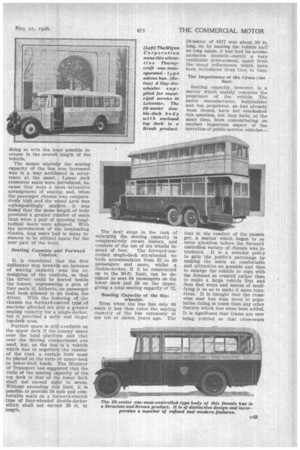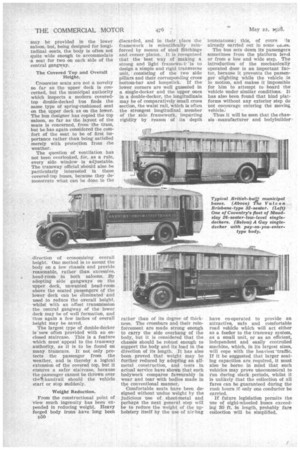THE IDEAL BUS FOR PRESENT-DAY NEEDS.
Page 122

Page 123

Page 124

If you've noticed an error in this article please click here to report it so we can fix it.
How the Bodybuilder and Chassis Manufacturer Have Combined to Produce a Vehicle Which Can Take the Place of the Tramcar.
THE bodybuilder who receives an. order from a municipal authority regards it as one which will increase his prestige. If he be able to give full satisfaction, it is an indication that he has been successful in working to a specification usually more rigid than that demanded by many private concerns. The bodybuilder who obtains repeat orders of this kind needs little further proof of the quality of his productions, and, if it be admitted that a state of rivalry exists between bus and tramcar, then it is to be expected that owners of tramway systems, when purchasing buses, will only be satisfied with the best, and will be keen critics of every detail of the construction.
Tramway companies have for several years past been buying an increasing number of buses, so that It would appear that both chassis manufacturer and bodybuilder have been able to supply vehicles which are not only acceptable, but which have sufficient merit to create for themselves a growing popularity.
The bus designer, although realizing that his vehicle is an independent unit and free from the disadvantages of running on a tramway track, has not allowed these factors to set up any feeling of self-satisfaction, but has always striven continually to improve his product so that the. bus shall more nearly approach the ideal of what a publicservice vehicle ought to be, with little regard to the comparisons which may be made with other forms of traction.
Continual Progress in Bus Design.
Keen competition has also proved ail effective stimulus in promoting the general progress of the busbuilding industry. Also, whilst tramway authorities may have different requirements according to the locality served, this state of affairs is not so varied as obtains amongst private bus proprietors; consequently, fresh ideas and new adaptations are frequently being demanded, with the result that more detail improvements are made than would be the case if the bus were more stereotyped in its general design.
The many kinds of passenger chassis now available, both large and small, with forward or ordinary steering, of medium or ]ow loading height and mounted on four or six wheels, is some indication of what has been done to cater for a wide range of requirements. As each chassis is suitable for many types of bus body, it follows that the ultimate expression of the varying heeds of each locality is to be found in the variety of bodywork employed.
Seating Capacity and Crosswise Seats.
It has been alleged that the bus cannot hope to compete with the tram for dealing with the peak load at rush hours. Instead of regarding this allegation as a hopeless drawback, the motor manufacturer ' has paid the closest attention to the matter for some time past, with the object hot only of increasing the,. seating capacity of the bus but of doing so with the least possible increase in the overall length of the vehicle.
The means whereby the seating capacity of the bus was increased was in a way accidental in occurrence at the onset. Lower deck crosswise seats were introduced, because they were a more attractive arrangement of seating, and, when the passenger chassis was comparatively high and the wheel arch was correspondingly shallow, it was found that the same length of body provided a greater number of seats than when a pair of opposing longitudinal seats were adopted. With the introduction of the low-loading chassis, long seats had in many instances to be utilized again for the rear part of the body.
Seating Capacity and Forward Control.
It is considered that the first deliberate step towards an increase of seating capacity was the ledesigning of the controls, so that the driver could be seated beside the bonnet, representing a gain of four seats if, hitherto, no passenger had been allowed to sit beside the driver. With the lowering of the chassiS the forward-control type of machine afforded not only a greater seating capacity for a single-decker, but it provided a safer and larger top-deck area.
Further space is still available on the upper deck if the canopy space over the hind 'platform and that over the driving compartment are used, but, as the bus is a vehicle which has to negotiate the camber of the road, a certain limit must be placed on the ratio of upper-deck to lower-deck loads. The Ministry of Transport has suggested that the ratio of the seating capacity of the top deck to that of the lower deck shall not exceed eight to seven. Without exceeding this limit, it is possible to provide 56 safe and comfortable seats on a forward-control type of four-wheeled double-decker which shall not exceed 26 ft. in length.
The next stage in the task of enlarging the seating capacity is comparatively recent history, and consists of the use of six wheels in stead of four. The forward-controlled single-deck six-wheeled vehicle accommodates from 32 to 40 passengers and more, whilst a double-decker, if it be constructed up to the 30-ft. limit, can be designed to seat 34 passengers on the lower deck and 38 on the upper, giving a total seating capacity of 72.
Seating Capacity of the SixWheeler.
Even when the bus has only 68 seats it has then twice the seating capacity of the bus commonly in use ten or eleven years ago. The
34-seater of 1917 was about 20 ft. long, so, by making the vehicle half as long again, it has had its accommodation doubled—surely a very creditable achievement, apart from the many refinements which have been introduced from time to time.
The Importance of the Cross "A. ise Seat. .
Seating capacity, however, is a matter which mainly concerns the proprietor of the vehicle. The motor manufacturer, bodybuilder and bus proprietor, as has already been shown, have not overlooked this question, but they have, at the same time, been concentrating on another important aspect of the operation a public-service vehicles
that is, the comfort of the passe& ger, a matter which began to re ceive attention before the forward. controlled variety of chassis was introduced. It is a sounder policy to gain the public's patronage by making the seats as comfortable and attractive as possible and then to enlarge the vehicle to cope with the demand so created rather than to make a large vehicle first and then find ways and means of modifying it so as to make it more luxurious. It is thought that the crosswise seat has done more to popularize riding in buses than any other feature which has since been added. It is significant that trams are now being refitted so that cross-seats
may be provided in the lower saloon, but, being designed for longitudinal seats, the body is often not quite wide enough to accommodate ,a seat for two on each side of the central gangway.
The Covered Top and Overall Height.
Crosswise seats are not a novelty so far as the upper deck is concerned, but the municipal authority which inspects a modern coveredtop double-decked bus finds the same type of spring-cushioned seat on the upper ,deck as on the lower. The bus designer has copied the top saloon, so far as the layout of the seats is concerned, from the tram, but he has again considered the comfort of the seat to be of first importance rather than being satisfied merely with protection from the weather.
The question of ventilation has not been overlooked, for, as a rule, every side window is adjustable. The tramway official should also he particularly interested in these covered-top buses, because they demonstrate what can be done in the direction of economizing overall_ height. One method is to mount the body on a low Chassis and provide reasonable, rather than excessive, head-room in both saloons. By adopting side gangways on the upper deck, unwanted head-room above the seated passengers of the lower deck can be eliminated and used to reduce the overall height, whilst with an offset transmission the central gangway of the lower deck May be of well formation, and thus again a few inches of overall height may be saved.
The largest type of double-decker is now often provided with an enclosed staircase. This is a feature which must appeal to the tramway authority, as it is to be found on many tramcars. It not only protects the passenger from the weather, and is thereby a logical extension of the covered top, but it ensures a safer staircase, because the passenger cannot be thrown over 0011 handrail should the vehicle start or stop suddenly.
Weight Reduction.
From the constructional point or view much ingenuity has been expended in reducing weight. Heavy forged body irons have long been D50 discarded, and in their place the framework is scientifically reinforced by means of steel flitchings and corner plates. It is recognized that the best way of making a strong and light framewo 1 'is to design a simple and rigid transverse unit, consisting of the two side pillars and their corresponding cross bottom-bar and hoopstick. If the lower corners are well gusseted in a single-decker and the upper ones in a double-decker, the longitudinals may be of comparatively small cross section, the waist rail, which is often the strongest longitudinal member of the side framework, imparting rigidity by reason of its depth rather than of its degree of thickness. The crossbars and their reinforcement are made strong enough to carry the side overhang of the body, but it is considered that the chassis should be robust enough to support the body and its load in the direction of its length. It has also been proved that weight may be further reduced by adopting an allmetal construction, and tests in actual service have shown that such bodywork compares favourably in wear and tear with bodies made in the conventional manner.
Comfortable seats have been designed without undue weight by the judicious use of sheet-metal and perhaps the next general step will be to reduce the weight of the upholstery itself by the use of air-bag inundations; this, of cours is already (tarried out in some ea..es.
The bus sets down its passengers sometimes from the platform level or from a low and wide step. The introduction of the mechanically operated door is an important factor, because it prevents the passenger alighting while the vehicle is in motion, and makes it impossible for him to attempt to board the vehicle under similar conditions. It has also been found that hind platforms without any exterior step do not encourage entering the moving vehicle.; Thus it will be seen that the chassis .manufacturer and bodybuilder have co-operated to provide an attractive, safe and comfortable road vehicle which will act either as a feeder to the tramway system, as a small unit, or as an efficient, independent and easily controlled machine, which, in its largest sizes, will cope with the heaviest 'traffic. If it be suggested that larger seating capacities are required, it must also be borne in mind that such vehicles may prove uneconomical to run during slack periods, whilst it is unlikely that the collection of all fares can be guaranteed during the rush hours if only one conductor be carried.
If future legislation permits the use of eight-wheeled buses exceeding 30 ft. in length, probably fare collection will be simplified.




















































































































































































































